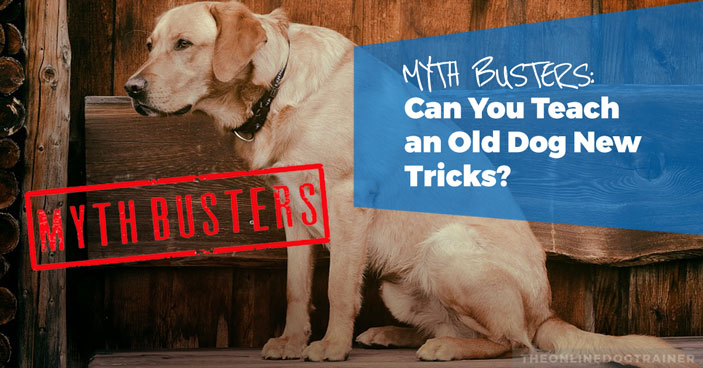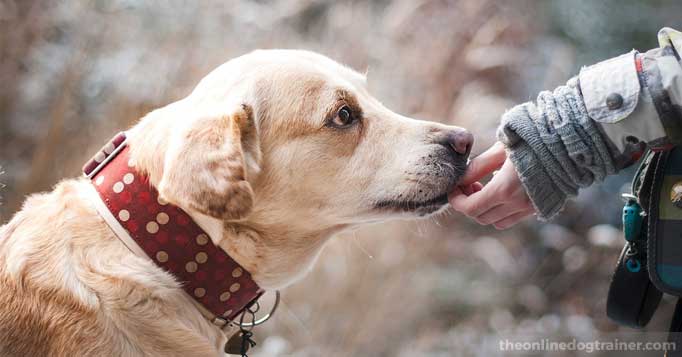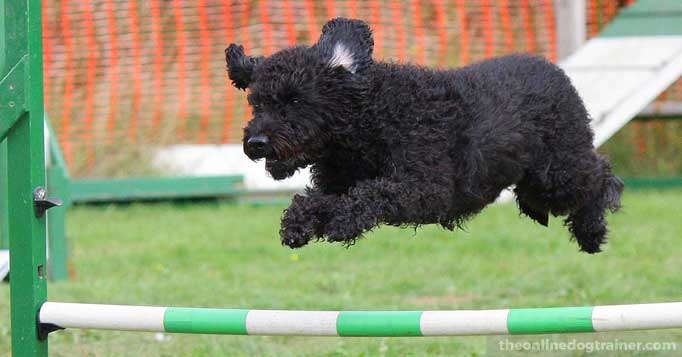
When I hear the myth “You can’t teach an old dog a new trick,” I also think of a quote which I believe to be true…
“If you always do what you’ve always done, then you’ll always get what you’ve always got!”
In other words, if you want to train a dog, no matter his age, to do something new, then you need to do something different while training him.
And you know what?
If you use the right approach, it will work!
Yet, unfortunately, when humans just repeat the same old actions to training a dog, and the dog fails to learn, we quickly label the dog “stupid” or “too old to learn,” which is simply not true.
So, can you teach an old dog a new trick?
Yes. Absolutely. But it starts with you… and me!
Ready to discover how to teach an old dog a new trick?
Here are some basic tips for training a dog to learn a new behavior…
1. Establish yourself as the decision maker.
If your dog takes no notice of you when you ask him to follow a command, it’s vital to establish that you are the decision maker first, before you begin training.
Why?
Because establishing yourself as the decision maker enables your dog to trust you. When he trusts you, he’ll be more likely to do something when you ask him to do it.
It’s just like having a child. If your child looks up to you because she knows you make decisions for her that will keep her safe and happy, she will be more likely to listen to you when you ask her to do something.
A great example would be keeping your child safe while cooking. If you tell your child not to touch a hot stove top because it will hurt her, and the child trusts you, chances are she’ll take your warning and directions seriously.
If the child couldn’t care less about what you have to say and she doesn’t trust you, there’s a good chance she’ll touch the burning stove top because she thinks she knows what’s best.
Always make sure your dog knows you’re the ultimate decision maker.
2. Don’t lose control of the environment.
While teaching your dog a new command, it’s so important to ensure the environment you’re teaching in is a controlled setting. It’s up to you to help your dog make the right decision.
For example, you may have a dog that charges out the front door and runs up and down the picket fence barking at people.
You don’t like this behavior, so you want to train your dog to not run out the door and bark.
Despite the fact you want to change this behavior, it’s summer outside, and you want to leave your doors open to let the fresh air into your home.
So, in this case, I’d install a baby gate just inside the door to help motivate your dog to make the right decision and stay inside, despite the fact that he wants to bark at people along the fence.
That baby gate will often make all the difference to the training pattern.
And over time, he’ll learn that he is not allowed to rush out the door without your permission.
Keeping control of the environment may mean keeping your dog on a long line or leash or putting a gate up in your home. Do whatever you need to do to keep control of your dog while you are teaching a behavior.
Back to the parent/child analogy…it’s like holding a toddler's hand as you walk through a busy parking lot.
Holding your kid’s hand is taking control of the environment, and it ensures that your kid won’t do something silly like run out in front of a car because she wasn’t paying attention.
While you’re holding your kid’s hand, you begin to teach her that it’s important to walk slowly through a parking lot, to look for cars and to always look both ways before walking across a street.
This is how practically controlling the environment allows you to train your dog (and your child) while also keeping them safe.
3. Remember your dog is trying to avoid pain and gain pleasure!

I’m a firm believer than we need to do more than just bribe and train our dogs with food and treats while training; however, they can certainly motivate a dog to learn a new skill.
So use treats and then fade them out later over time as your dog gets the hang of the new action.
Also keep in mind that different foods may motivate different behaviors. spelling
To a dog, a piece of kibble is like 10 cents.
Then a big dry biscuit is like a dollar to your dog.
And if you take it a step further, a piece of cheese or bacon is like $100 dollars.
And what your dog may do for $100, he may not do for 1o cents.
(Maybe we are not so different after all!)
For example, if your dog escapes and gets out of the house, a piece of kibble may not be enough to make him listen and come back to you. Yet, I’m sure a shake of the tasty treat tin will grab his attention and motivate him to come back inside.
4. Start small and set your dog up to win.
We should always be looking for ways to set up our dogs to win when they are being trained.
For example, if you’re trying to break the habit of your dog raiding your garbage bin, it’s no good leaving the leftover lamb chop bones in the trash.
It’s just too tempting for your dog, especially when he has not learned that the trash is off limits for him.
Make it easy and keep it simple when you are starting out.
5. Finish on a high and exercise regularly!

Always end your training session on a high note.
This may even be as simple as ending your training session on a basic recall or finishing the walk with a treat when they come and jump up into the car. When you do this, you always leave a training session feeling happy, and the dog you’re working with finishes a session feeling confident and willing to learn.
So, can you teach an old dog a new trick? Follow my 5-step method above, and the answer is YES!
But what about you?
Are you too old to learn a new skill or try out a new career path?
Listen to this…
My amazing dad, alongside my nephew and me, just climbed Ben Nevis, the highest mountain in the UK!
He climbed up and down in a single day! And he’s 70!
In case you are wondering, yes, he is the one in the middle of the photo 🙂

A few weeks later, dad went on his first hot air balloon trip.
And a teenager in our village just launched a super recipe book.
So the answer is no!
You are never too old or too young to start something new! Age is simply a number. What really counts is what you believe and feel.
In the words of Henry Ford, “Whether you think you can or whether you think you can't, you're right.”
So if you’ve been reading some of the latest posts and have been thinking about becoming a dog trainer but aren’t sure if you can do it…choose the empowering belief that you can!
Whether it's as a full-time or part-time job, as a hobby or as an extra income to supplement your current salary, believe, and it can come true.
And when it comes to your dog… it's true…old dogs CAN learn new tricks!
Dogs can change. The question is, can YOU?
If you're interested in finding out more about being a dog trainer, I invite you to request more information about my Dog Trainer Academy program!

Get more info on the Dog Trainer Academy program.
If becoming a dog trainer isn't the right path for you to take right now, I highly encourage that you instead check out my program called The Dog Calming Code.
This program will teach you everything you need to know in order to get your dog to calm down and listen to you when it matters most. Best of all, these methods will never go “out of style” so, if in the future you decide you want to pursue dog training, you'll have a solid training foundation to use with all your clients.
Check out The Dog Calming Code here!
Or, if you have a puppy in your home, take a look at my Puppy Coach training program!

~Doggy Dan 🙂







6 Responses
My dog is not treat/food motivated. As a matter of fact, I have to constantly urge him to eat. That makes training a little more difficult.
Hi Jan!
There are lots of dogs who aren’t at all food motivated so it can be helpful to find something that does work to motivate them. It may be a favourite toy, play or even just some praise and affection. Take care, Doggy Dan.
Help with puppy training crate and chewing on leash on walks
Hi Jay, check this out… http://theonlinedogtrainer.com/how-to-stop-your-dog-from-chewing-the-leash/
Loved this inspiring article Doggy Dan. Can’t wait for the launch of your Dog Trainer Academy.
Best Wishes Jan Marie x
Thanks Jan, the course will launch in a couple of weeks…You’ll receive the first videos at the start of May, thanks for your patience and interest. Cheers Dan